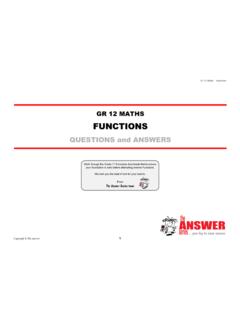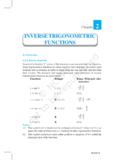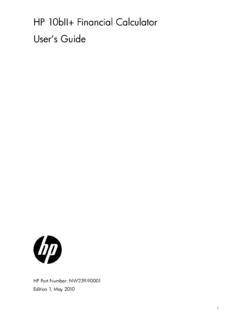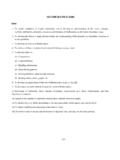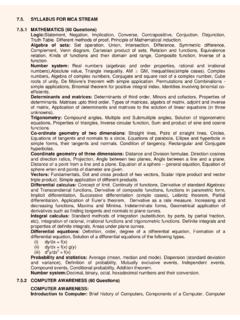Transcription of CLARKE & PARK TRANSFORMS ON THE TMS320C2xx
1 CLARKE & park Transformson the TMS320C2xxApplication ReportLiterature Number: BPRA0482 IMPORTANT NOTICE Texas Instruments (TI) reserves the right to make changes to its products or to discontinue any semiconductorproduct or service without notice, and advises its customers to obtain the latest version of relevant information toverify, before placing orders, that the information being relied on is warrants performance of its semiconductor products and related software to the specifications applicable atthe time of sale in accordance with TI s standard warranty. Testing and other quality control techniques areutilized to the extent TI deems necessary to support this warranty. Specific testing of all parameters of eachdevice is not necessarily performed, except those mandated by government application using semiconductor products may involve potential risks of death, personal injury, or severeproperty or environmental damage ( Critical Applications ).
2 TI SEMICONDUCTOR PRODUCTS ARE NOT DESIGNED, INTENDED, AUTHORIZED, OR WARRANTED TOBE SUITABLE FOR USE IN LIFE-SUPPORT APPLICATIONS, DEVICES OR SYSTEMS OR OTHER of TI products in such applications is understood to be fully at the risk of the customer. Use of TIproducts in such applications requires the written approval of an appropriate TI officer. Questions concerningpotential risk applications should be directed to TI through a local SC sales order to minimize risks associated with the customer s applications, adequate design and operatingsafeguards should be provided by the customer to minimize inherent or procedural assumes no liability for applications assistance, customer product design, software performance, orinfringement of patents or services described herein.
3 Nor does TI warrant or represent that any license, eitherexpress or implied, is granted under any patent right, copyright, mask work right, or other intellectual propertyright of TI covering or relating to any combination, machine, or process in which such semiconductor products orservices might be or are 1997, Texas Instruments Incorporated3 Table of .. and park TRANSFORMS in the Field Orientated Control (FOC) consideration.. Mathematical CLARKE Mathematical park Mathematical Inverse park and CLARKE TRANSFORMS .. TRANSFORMS and park implementation on the C2xx .. Conventions .. C-compatible functions .. compatible functions .. Functions .. assembly park assembly compatible .. C park C compatible .. Processor utilization (maximum) .. park .. + Inverse park .. Memory utilization.
4 park .. + Inverse park .. Main assembly example to call park and inverse park functionwithout cos/sin calculation in inverse Main assembly example to call park and inverse park functionwith cos/sin calculation in inverse park .. Clarke_Park function for assembly main .. Inverse park function without cos/sin calculation for assemblymain .. Inverse park function with cos/sin calculation for assemblymain .. Main C example to call park and inverse park function withoutcos/sin calculation in inverse park .. Main C example to call park and inverse park function withcos/sin calculation in inverse park .. Clarke_Park function fully C compatible without cos/sinparameters Clarke_Park function fully C compatible with cos/sinparameters Inverse park function fully C compatible with cos/sincalculation .. Inverse park function fully C compatible without cos/sincalculation.
5 4351. OverviewClarke and park TRANSFORMS are used in high performance drive architectures(vector control) related to permanent magnet synchronous and asynchronousmachines. In this paper, the user will find functions to easily implement Clarkeand park TRANSFORMS to his the use of the CLARKE transform , the real (Ids) and imaginary (Iqs)currents can be identified. The park transform can be used to realize thetransformation of the Ids and the Iqs currents from the stationary to the movingreference frame and control the spatial relationship between the stator vectorcurrent and rotor flux CLARKE and park TRANSFORMS in the Field OrientatedControl (FOC)The FOC consists of controlling the components of the motor stator currents,represented by a vector, in a rotating reference frame d,q aligned with the rotorflux. The vector control system requires the dynamic model equations of theinduction motor and returns the instantaneous currents and voltages in order tocalculate and control the electric torque of an AC induction motor can be described by theinteraction between the rotor currents and the flux wave resulting from thestator currents induction.
6 Since the rotor currents cannot be measured with cagemotors, this current is replaced by an equivalent quantity described in a rotatingsystem coordinates called d,q following the rotor CLARKE transform uses three-phase currents ia, ib and ic to calculate currentsin the two-phase orthogonal stator axis: i and i . These two currents in the fixedcoordinate stator phase are transformed to the isd and isq currents components inthe d,q frame with the park transform . These currents isd, isq and theinstantaneous flux angle , calculated by the motor flux model, are used tocalculate the electric torque of an AC induction i idiq +Stator current in the d,q rotating reference frameand its relationship with the a,b and c stationary reference such a transformation, the stator variables (currents and angle) aretranslated into a flux model. This flux model is compared with the referencevalues and updated by a PI controllers.
7 After a back transformation from field tostator coordinates, the output voltage will be impressed to the machine withPulse Width Modulation (PWM).3. Mathematical Mathematical CLARKE mathematical transformation called CLARKE transform modifies a three-phase system to a two-phase orthogonal system:iiiiiiiiiiiabcbcabc = = =++23132323()()()withi and i components in an orthogonal reference frame andio the homopolar component of the many applications, the homopolar component is absent or is less this way, in absence of homopolar component the space vector u = u + ju represents the original three-phase input now a particular case with i superposed with ia and ia + ib + ic is zero,in this condition ia, ib and ic can be transformed to i and i with followingmathematical transformation:iiiiiiiiaababc == +++= Mathematical park two phases , frame representation calculated with the CLARKE transformis then fed to a vector rotation block where it is rotated over an angle to followthe frame d,q attached to the rotor rotation over an angle is done according to the formulas:iiiiiisdsq= + = + cos( )sin( )sin( )cos( ) Mathematical Inverse park and CLARKE vector in the d, q frame is transformed from d, q frame to the two phases , frame representation calculated with a rotation over an angle according tothe formulas:iiiiiisdsqsdq = = + cos( )sin( )sin( )cos( )8 The modification from a two-phase orthogonal , frame to a three-phasesystem is done by the following equations.
8 Iiiiiiiiabc== + = TRANSFORMS Parka, b, c -> , d, q -> , iiiiiiiiiiiabcbcabc = = =++23132323()()() iiiiiiiiaababc == +++=13230iiiiiisdsqsdq = = + cos( )sin( )sin( )cos( ) , > d, q , > a, b, ciiiiiisdsq= + = + cos( )sin( )sin( )cos( )iiiiiiciiab== + = 123212329 With vectors conventions:iaibici i idiq +4. CLARKE and park implementation on the ConventionsTwo different versions of each function are presented in this document, fully Ccompatible functions and assembly calling examples of assembly and C program calling park and Park_inversetransforms are in the Fully C-compatible functionsFully C compatible functions use C convention to use the stack for parameterspassed to the functions. Parameters returned by functions are passed by of a C called function are managed.
9 Stack pointer AR1 is wellpositioned and the return address of the hardware stack is popped in case of aC interrupt events using C-function features (stack). The frame pointer is notmodified. Register AR6/AR7 are not Assembly compatible functionsAssembly compatible functions do not use their own variables, variables usedare in a are passed by the stack and the AR1 point to the stack just after thelast argument. In return from function, results are in the stack. Register AR0,AR6 and AR7 are not park assembly compatibleFunction park with CLARKE and park TRANSFORMS is in the annexe with a mainassembly example. Conventions to interface with this function are: Input:parameters are in the stack pointed by AR1 (AR1 point the address in thestack just after Angle parameter) with the following order:- current ia -32768<ia<32767- current ib -32768<ib<32767- ANGLE parametersThe value of this angle is unsigned:0 <-> 0000h90 <->4000h180 <->8000h240 <->C000h Output:isd , isq, sin(angle) and cos(angle) are in the stack in this order with the samefixed point format than ia, ib in input.
10 AR1 point on and SIN calculation are done by a single function for better optimizationwith Table Look-up and Linear Interpolation (Cf: application note Sine &Cosine on the TMS320C2xx ).Calculations are done with fixed point instruction to optimize the timecalculation. The dynamic used in calculation fit with maximum precision andoverflow is Inverse park assembly compatibleTwo Functions Inverse park assembly compatible are in the annexe. Onefunctions recalculates the sine and the cosine of angle in case these values arenot saved in park function return. The second functions use sine and cosinepassed in parameters for are done with fixed point instructions to optimize the timecalculation. The dynamic used in calculation fit with maximum precisionoverflow is Inverse park assembly compatible with cos, sin calculationConventions to interface with the first function are: Input:parameters are in the stack pointed by AR1 (AR1 points to the address in thestack just after Angle parameter) with the following order:- current isd -32768<isd<32767- current isq -32768<isq<32767- ANGLE parameterThe value of this angle is unsigned:0 <-> 0000h90 <->4000h180 <->8000h240 <->C000h Output: ia, ib, ic are in the stack in this order with the same fixed point formatthan id, iq in input.










